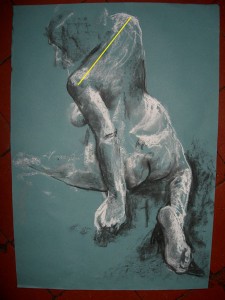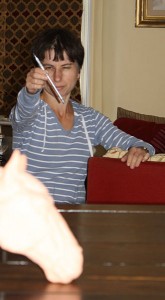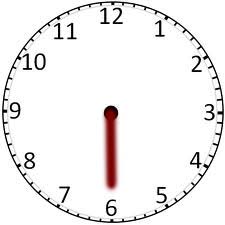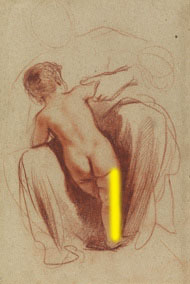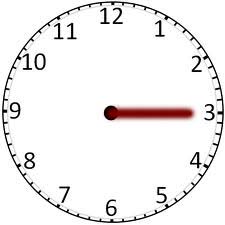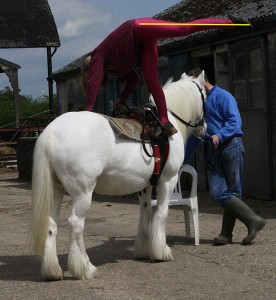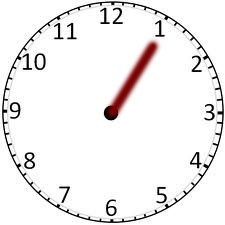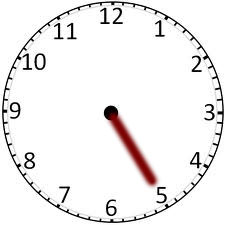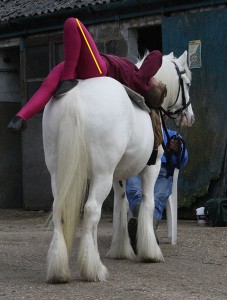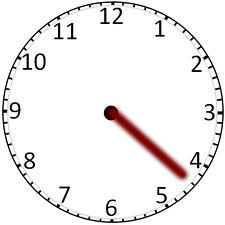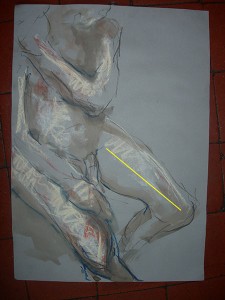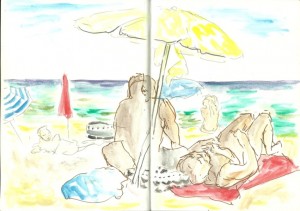Life drawing tutorial: Estimating slopes and angles
August 28, 2012
Which way are bits of your life model tipping?
Why are diagonal lines so important in life drawing?
A great way to bring interest to a life drawing composition (whether human or animal) is to create powerful diagonal lines within the picture. These may be produced by an actual tipping of the body, by limbs crossed or out at an angle, or by positioning the figure well above or below the artist’s own eye level. This last trick results in foreshortening, and that produces the effect of lines being angled away from horizontal or vertical.
Getting those slopes and angles “right” can make a drawing really convincing.
Measuring and checking angles…will this make the drawing boring?
Some artists push themselves to work in a purely inspirational way, aiming to get the gist of what they see straight down onto the paper without much logical thought. That outlook can lead to a free and bold picture, but I do recommend that you “stop and get logical” now and again. If faced with a new pose, a new animal species or a surprising bit of foreshortening, even experienced artists do pause to check proportions and angles.
For example, Vincent Van Gogh, who is thought of by many as an artist who was driven by inspiration to create highly emotive work, actually gave great importance to the measurement of his subjects. One of the first books to inspire him was Cassagne’s “Guide de l’ABC du dessin”, a clear book on perspective, and it is even thought that he used a perspective frame device throughout much of his working life. The fact that Van Gogh thought logically about proportions and angles does not diminish his work but gives it even greater emotional punch. The slopes and angles in his work create such an illusion of real life that the other aspects of his handling are seen as genuinely surprising.
So how do we estimate slopes and angles?
Students are all taught to measure proportions by holding a pencil up at arm’s length. Techniques for checking slopes and angles are, however, sometimes missed out of art courses.
As a separate technique from measuring proportions, I like to hold my pencil up to check angles. This is what I do:
Take a straight drawing tool, whether pen, pencil or straight piece of charcoal:
Hold it up between your own eye and the sloping part of the model that you are checking. Tip the pencil so that it is sloping by the same amount as the sloping part of your model.
For this technique, it is not essential that the pencil is held out at arm’s length (we are not checking proportions here).
In the photo above, I am checking the slope of the front of this terracota horse’s head. As you can see, I am closing one eye during this process. This makes it easier to line the graphite stick up in front of the horse’s head so that, from where I am sitting, the two objects are superimposed.
Top tip: Keep the pencil in the same plane as your own face. What I mean by that, is that you mustn’t have one end of the pencil further away from your face than the other end.
Another top tip: Keep your head fairly upright. Don’t tip it to one side.
Now you need to estimate the angle of the slope. My own trick is to compare angles with the time on a clock face. I think of the minute hand on a clock. A vertical line is like “half past the hour”:
A horizontal line is like “quarter past”:
“Five past”:
Twenty-five minutes past:
The next step is to transfer the sloping line to your page. The edges of your paper are vertical and horizontal. If you have decided that a line on the model is actually vertical, then draw it parallel to the vertical edge of your paper. For tipped lines, think of your clock face again, and draw the slope like the angled minute hand on your imagined clock.
I like the clock-face method because I do not have to stop and think about it too much. Without being a confident mathematician, I can even become quite precise about a degree of slope, e.g. recognising it as “22 minutes past the hour” without giving myself a headache:
Comparing angles on the model to those of background objects
Objects in the background can often help to orientate you when drawing a human or animal figure. Even in a quick sketch, do consider putting in a few background lines behind your figure.
If you lucky enough to be at the beach then do include the horizon. That is a known horizontal line:
In the studio, you may be able to include the occasional vertical edge of door frames or window edges. If thinking of angles and clock faces, visible vertical lines in the background are “half past the hour” lines and are useful to compare with sloping parts of the model.
You may notice many horizontal objects behind and around your model, e.g. skirting board edge, horizontal edges of doors and window frames. However, these should mostly not be drawn horizontal on the page! Only those horizontal lines that are at the artist’s eye level will end up appearing horizontal within the picture. All of the others end up as interesting diagonal lines on your paper and canvas. This last point is rather curious. If anyone wants me to focus on that as a post in itself then just let me know.
Key points:
Diagonal lines in your picture help to create an interesting composition.
You can hold up a straight edge to check the slope of an object before you draw it.
Think of angles as the minute hand on a clock as you transfer to the picture.
Remember that lines that are horizontal in real life will almost always need to be tipped/ angled within your picture.
